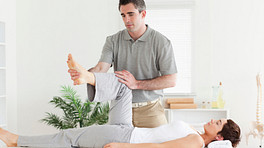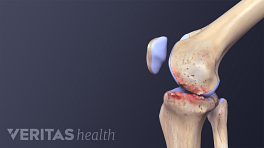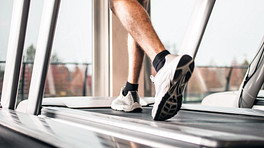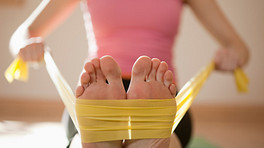Research suggests that losing excess weight is one of the best ways to reduce and prevent knee arthritis pain. This is true whether weight loss is achieved through exercise or diet alone. 1 Newberry SJ, FitzGerald J, SooHoo NF, Booth M, Marks J, Motala A, Apaydin E, Chen C, Raaen L, Shanman R, Shekelle PG. Treatment of Osteoarthritis of the Knee: An Update Review [Internet]. Rockville (MD): Agency for Healthcare Research and Quality (US); 2017 May. Available From http://www.ncbi.nlm.nih.gov/books/NBK447543/. PubMed PMID: 28825779.
In fact, losing weight is more effective at reducing knee pain than many other commonly used knee arthritis treatments, such as strength training and glucosamine/chondroitinsupplements, as well as newer regenerative medicine treatments, such as PRP injections. 1 Newberry SJ, FitzGerald J, SooHoo NF, Booth M, Marks J, Motala A, Apaydin E, Chen C, Raaen L, Shanman R, Shekelle PG. Treatment of Osteoarthritis of the Knee: An Update Review [Internet]. Rockville (MD): Agency for Healthcare Research and Quality (US); 2017 May. Available From http://www.ncbi.nlm.nih.gov/books/NBK447543/. PubMed PMID: 28825779. Many patients can put off the need for knee replacement surgery by losing weight.
In This Article:
- How Effective is Weight Loss for Treating Knee Arthritis Pain?
- Tips for Losing Weight to Treat Knee Pain
Why Is Weight Loss Such an Effective Treatment?
Weight loss takes pressure off arthritic knee joints. Losing weight reduces friction between the bottom of the femur (thigh bone) and top of the tibia (shin bone), where protective knee cartilage has been damaged or worn away. Losing weight also puts less strain on the knee’s soft tissues, including ligaments and tendons.
Compressive Load on the Knee: The Compounding Effect of Extra Weight
The pressure on a knee joint at any given time is referred to as the “compressive load” on the knee. The compressive load changes according to activity. For example, compressive load on the knees when—
- Lying down is 0 lbs
- Standing upright is equal to a person’s bodyweight
- Walking is estimated to be 3 times a person’s bodyweight 2 D’Lima DD, Fregly BJ, Patil S, Steklov N, Colwell CW. Knee joint forces: prediction, measurement, and significance. Proceedings of the Institution of Mechanical Engineers Part H, Journal of Engineering in Medicine. 2012;226(2):95-102. , 3 Messier SP, Gutekunst DJ, Davis C, DeVita P. Weight loss reduces knee-joint loads in overweight and obese older adults with knee osteoarthritis. Arthritis Rheum. 2005 Jul;52(7):2026-32. PubMed PMID: 15986358.
In other words, experts estimate that when a foot hits the ground during walking, the knee experiences 3 lbs of pressure for every 1 lb of bodyweight. This means a person who weighs 150 lbs may feel 450 lbs of pressure in a knee during one stride.
Losing a few pounds can make a big difference over time
Reducing the compressive load on the knees can make a significant difference when added up over many steps.
To illustrate this point, below are compressive load calculations for a person who is 5’4” and walks one mile, requiring about 2,300 steps. 4 Hoeger W, Bond L, Ransdell L, Shimon JM, Merugu S. One-mile step count at walking and running speeds. ACSM’s Health and Fitness Journal, 12(1):14-19, January/February 2008. http://www.yamaxx.com/digi/m-magazine/ACSM_Health%26FitnessJournal.pdf. Accessed February 28, 2017. In the first set of calculations, the person weighs 150lbs; in the second set of calculations, the person weighs 140lbs.
- (150lbs x 3) x (2,300 strides per mile) = 1,035,000 lbs in compressive load per mile (517,500 lbs per knee)
- (140lbs x 3) x (2,300 strides per mile) = 966,000 lbs in compressive load per mile (483,000 lbs per knee)
By losing 10 pounds, the person in this example can reduce the cumulative compressive load on his or her knees by 69,000 lbs, a 6.7% difference. Added up over days, months, and years of walking, losing 10 lbs can be quite significant in easing knee pain as well as reducing wear and tear on the knees.
Variations in compressive load
Many experts estimate that during one walking stride the knee experiences 3 lbs of pressure for every pound of body weight, but others estimate anywhere between 2 lbs to 7 lbs of pressure for every pound of body weight.
5
Bergmann G, Bender A, Graichen F, et al. Standardized Loads Acting in Knee Implants. Williams BO, ed. PLoS ONE. 2014;9(1):e86035. doi:10.1371/journal.pone.0086035.
The exact figure can vary depending on body mechanics, walking surface, and other factors. Ultimately, experts agree that the compressive load on knees (and hips, and ankles) is a multiple of bodyweight, and that losing excess weight can play a significant role in reducing knee pain.
- 1 Newberry SJ, FitzGerald J, SooHoo NF, Booth M, Marks J, Motala A, Apaydin E, Chen C, Raaen L, Shanman R, Shekelle PG. Treatment of Osteoarthritis of the Knee: An Update Review [Internet]. Rockville (MD): Agency for Healthcare Research and Quality (US); 2017 May. Available From http://www.ncbi.nlm.nih.gov/books/NBK447543/. PubMed PMID: 28825779.
- 2 D’Lima DD, Fregly BJ, Patil S, Steklov N, Colwell CW. Knee joint forces: prediction, measurement, and significance. Proceedings of the Institution of Mechanical Engineers Part H, Journal of Engineering in Medicine. 2012;226(2):95-102.
- 3 Messier SP, Gutekunst DJ, Davis C, DeVita P. Weight loss reduces knee-joint loads in overweight and obese older adults with knee osteoarthritis. Arthritis Rheum. 2005 Jul;52(7):2026-32. PubMed PMID: 15986358.
- 4 Hoeger W, Bond L, Ransdell L, Shimon JM, Merugu S. One-mile step count at walking and running speeds. ACSM’s Health and Fitness Journal, 12(1):14-19, January/February 2008. http://www.yamaxx.com/digi/m-magazine/ACSM_Health%26FitnessJournal.pdf. Accessed February 28, 2017.
- 5 Bergmann G, Bender A, Graichen F, et al. Standardized Loads Acting in Knee Implants. Williams BO, ed. PLoS ONE. 2014;9(1):e86035. doi:10.1371/journal.pone.0086035.











